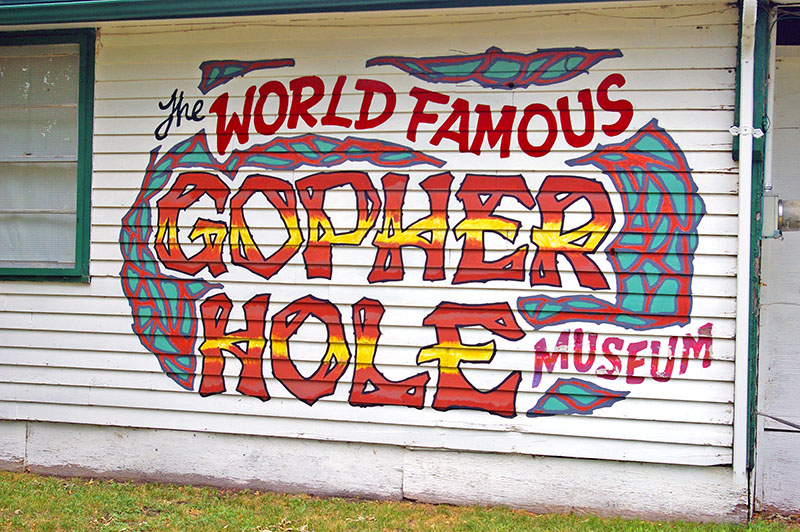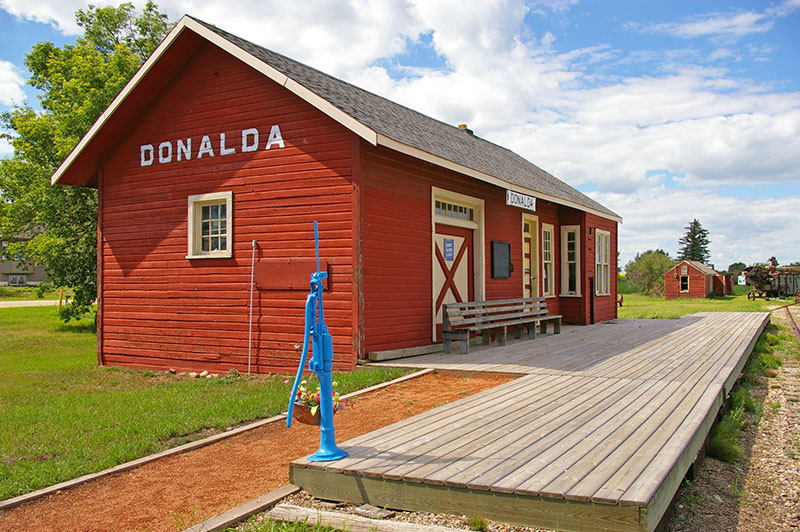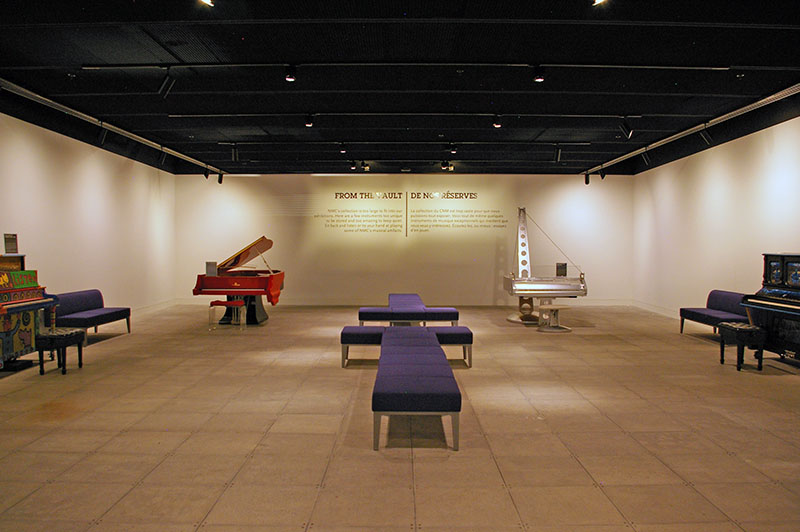
Click the image for more photos of the Torrington Gopher Hole Museum
In 1995, a group of townspeople decided to create a small museum in order to put the hamlet of Torrington “on the map.” After debating various ideas, the group determined to focus its efforts on a local pest/resident well known to the prairies, namely the Richardson’s ground squirrel, or gopher, famous both for disrupting agricultural land with its burrows and looking cute in photographs taken by tourists. The exhibitions inside a small converted house consist of rows of dioramas, or small boxes in which stuffed gophers dressed in hand-made clothing enact scenes related to rural life in the region, both past and present, including agriculture, hunting, and tobogganing. Much to the surprise of its organizers, the Gopher Hole Museum opened amidst an international storm of debate, and it continues to attract visitors from around the world, providing a focal point for the town of Torrington and its identity. In 1995, PETA [People for the Ethical Treatment of Animals] officials sent letters of protest to the mayor of Torrington, asking that prefabricated models be used in the exhibitions, instead of gopher corpses. Apparently, the Torrington Tourism Committee replied by sending PETA a postcard advising its members to “get stuffed.” The best known diorama in the Gopher Hole Museum responds to this debate; it depicts a protest taking place on the sidewalk outside of the Village Office. Two gophers play tug of war with the body of a third gopher. A figure dressed in a navy vest, bow tie and top hat insists that “This one is needed for the museum,” while his rival, a bearded gopher adorned with a long ponytail and a purple poncho, shouts “Save the endangered species!!”



Other Unique Museums of Interest:
Donalda and District Museum (Donalda Lamp Museum)

Click the image for more for photos of the Donalda and District Museum
Unlike the Torrington Gopher Hole Museum, this unique museum was not deliberately constructed to highlight or rebrand the town. Instead, it was formed when residents of Donalda, Beth and Don Lawson, donated their collection of almost 900 lamps dating from 1600 to the 1920s to the town. The museum was then founded and eventually expanded to include some Métis and indigenous objects, as well as a range of material objects donated by people from the region. In 2000, the world’s largest replica of an oil lamp was built in Donalda as a millennium project to create a visual feature for the town, celebrating the impressive collection of kerosene lamps that remain the prime attraction inside the museum proper. In this case, the town of Donalda became associated with lamps due to the collecting of two local residents; lamps were never produced in the town itself, though the museum administration now manages several historic buildings, including the 1955 Cooperative Donalda Creamery, which produced award winning butter until 1987.
National Music Centre

Click the image for more photos of the National Music Centre
Studio Bell, which opened in the summer of 2016, is a massive new interpretive centre occupying two blocks in Calgary’s East Village. The historic King Edward Hotel, famous for its blues heritage, has been restored and incorporated into the new building and will continue to be a live performance venue. Studio Bell has five floors of highly innovative and interactive exhibits, a 300-seat performance venue, a restoration lab, broadcast facilities, recording studios and music residencies. Every exhibit offers multiple levels of immersion, from traditional text panels to interactive touch screens to instruments that they can play themselves. Many areas have high-quality earphones to listen to musicians speak, to hear instruments unique sounds, even to listen to entire compositions. Despite massive corporate and government funding, the museum puts the politics of music front and centre with an exhibit on protest music. Originally a private collection of synthesizers, the museum’s collection has grown to include historical and contemporary instruments, as well as costumes and props of many Canadian performers. The museum also houses the Canadian Music Hall of Fame and the Canadian Country Music Hall of Fame, each with temporary exhibits on the current inductees. NMC also publishes Amplify, an "annual report to the community."
YouthLink
Calgary:

Click the image for more photos of YouthLink Calgary
Based on the theme of “Crime and its Consequences”, YouthLink is a major new interpretive centre using the latest technologies to create an immersive, interactive learning environment. After its downtown facility was affected by flooding in 2013, plans for the new centre were accelerated. With a mix of adult and youth-oriented exhibits, the museum shows not only the history of the Calgary Police service and the science of forensics, it also deals with ongoing crime-related issues such as gangs, drugs, bullying, cybercrime, and domestic abuse. It even provides safe alcoves where individuals can discreetly ask for help. Unfortunately, the museum’s branding is counterintuitive, portraying a children’s learning environment rather than a broad-based interpretive centre for all ages. The new site in Calgary’s northeast also has poor wayfinding, another issue that is slowly being tackled.


 Heritage Museumstop of page
Heritage Museumstop of page












 Heritage Museumstop of page
Heritage Museumstop of page